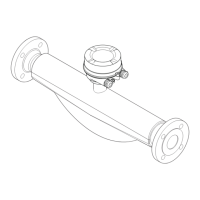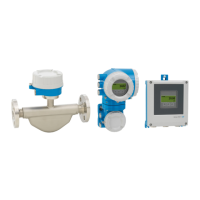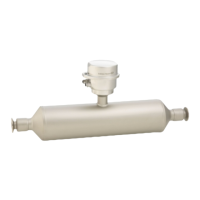Proline Promass F 100 Modbus RS485 Technical data
107
Pressure-temperature
ratings
An overview of the pressure-temperature ratings for the process connections is
provided in the "Technical Information" document
Secondary containment For the Standard version with the temperature range –50 to +150 °C (–58 to +302 °F), the
sensor housing is filled with dry nitrogen gas and protects the electronics and mechanics
inside.
For all other temperature versions the sensor housing is filled with dry inert gas.
The following secondary containment pressure ratings/burst pressures are only valid for
standard devices and/or devices equipped with closed purge connections (never opened/as
delivered).
If a device fitted with purge connections (order code for "Sensor option", option CH "Purge
connection") is connected to the purge system, the maximum nominal pressure is
determined by the purge system itself or by the device, depending on which component
has the lower nominal pressure classification.
If the device is fitted with a rupture disk (order code for "Sensor option", option CA "Rupture
disk"), the rupture disk trigger pressure is decisive for the maximum nominal pressure
→ 108.
The secondary containment burst pressure refers to a typical internal pressure achieved
prior to mechanical failure of the secondary containment as determined during type
testing. The corresponding type test declaration can be ordered with the device (order code
for "Additional approval", option LN "Type test containment").
DN Secondary containment
pressure rating
(designed with a safety factor
≥ 4)
Secondary containment burst pressure
[mm] [in] [bar] [psi] [bar] [psi]
8 ³⁄₈ 40 580 255 3 698
15 ½ 40 580 200 2 900
25 1 40 580 280 4 060
40 1½ 40 580 180 2 610
50 2 40 580 195 2 828
80 3 25 362 105 1 522
100 4 16 232 85 1 232
150 6 16 232 80 1 160
250 10 10 145 57 826
If a measuring tube fails (e.g. due to process characteristics like corrosive or abrasive
fluids), the fluid will be contained by the secondary containment.
If there is a need to drain the leaking medium into a discharge device, the sensor should be
fitted with a rupture disk. Connect the discharge to the additional threaded connection .
If the sensor is to be purged with gas (gas detection), it should be equipped with purge
connections.
Do not open the purge connections unless the containment can be filled immediately
with a dry, inert gas. Use only low pressure to purge. Maximum pressure:
5 bar (72.5 psi).

